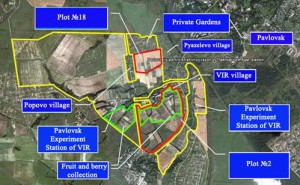On the occasion of the World Cowpea Conference 2010 in Dakar, which is going on now and has resulted in some press interest, IITA have published an interview with the manager of their genebank. Which of course maintains the world’s largest cowpea collection on behalf of us all. Many of the points she makes are addressed in the global strategy for conservation and use of cowpea genetic resources, which I believe she’ll be presenting in Dakar. Dominique doesn’t mention core collections, but another IITA article does. We even have the results of a gap analysis for wild Vigna in Africa. And finally, also doing the rounds is a summary of the results of a survey of users of the collection. Though I wouldn’t bet the farm on those cost numbers turning out to be accurate. Do we have any readers in Dakar who’d like to tell us what’s going on?
Pavlovsk commission presents its results
Thanks to Tatyana Livshultz, we have a translation of the interview with the members of the expert scientific commission that was appointed by the Russian Government Department of Economic Development to examine and report on the living collections at the Pavlovsk Experimental Station.
Here’s Tatyana’s summary of the main findings:
1) The station holds extremely valuable (from scientific, agronomic, and historical perspective) living collections particularly the stone fruits (which was assembled beginning 80-85 years ago by the Vavilov Institute) and currants (which is a younger collection).
2) Some of these collections (particularly the stone fruit) are in very bad condition (old trees at risk of death) and need urgently to be renewed (re-grafted, re-propagated); others (e.g. the currants) are relatively well-maintained. The brambles are overgrown by grasses.
3) The collection has not been well-documented or well-maintained. They recommend a change of management/administration at the Pavlovsk Experiment Station, and additional resources made available for maintenance and repropagation of the collection.
4) They recommend that the station be maintained. The 13 hectares where the fruit collections are currently planted must be maintained, an additional 20 hectares are needed to renew and re-propagate the collection while maintaining the original plantings. Additional areas that do not hold collections (e.g. a wetland) or are currently planted with field crops (grains or potatoes) are identified as unnecessary to protect and may be developed.
5) The commission recommends against moving the fruit collection, considered too risky (too great a risk of loss of accessions).
Well, that sounds pretty hopeful to me. 1
Pavlovsk interpretation depends on the kindness of strangers
Can you help provide a precis of this broadcast, “Results of evaluation conducted by the expert commission regarding the state of lands belonging to the Pavlovsk Experiment Station.”
And thanks to commenter Mike H for the link to the VIR site.
Pavlovsk: you are here
Chaffey’s regular words of wisdom on anything botanical. Well, mostly wise. But more on that later…
That’s from a nibble a few days ago. The qualification concerned Pavlovsk, and Jeremy has now set the record straight. Incidentally, the latest update on the situation from the Vavilov Institute itself has the first decent map of Pavlovsk I’ve seen. Here it is. Explore for yourself: no Street View, alas.

Nibbles: Pavlovsk, Baobab hybridization, Jackfruit, Vavilovia, Cowpea education, Lead, Bees, Banana wilt, Dariy cows, Pavlovsk, Drylands, School gardens, Genetic diversity in botanic gardens
- The value of Pavlovsk. Jeremy delivers a slap.
- CIRAD on kinky sex among the baobabs.
- “I had never heard that there were distinct varieties of the jackfruit, although of course such a thing was reasonable, so I naturally wanted very much to taste one.” Naturally.
- Wild relative of pea gets a weird hybrid in-ex situ conservation treatment.
- A Cowpea Story, an illustrative children’s book by Vicky Inniss-Palmer, tells the hopeful story of a cowpea named Catalina and her struggle to overcome illness and disease with the help of scientists. Meanwhile, scientists meet.
- Urban gardeners, beware lead. And nurture your pollinators.
- Reading this, anyone would think nobody had ever researched banana Xanthomonas wilt.
- Improved dairying in Kenya.
- Vavilov Institute’s comprehensive update on Pavlovsk.
- ICRISAT to put in place new market-oriented strategy which will use a “systems perspective in setting our priorities to ensure that all important issues along the dryland agriculture value chain are addressed.”
- Meanwhile, ASARECA asks for ideas on how to intensify one of those dryland systems in the face of climate change.
- ICIMOD promotes herbal gardens in schools.
- Botanic gardens get wrists slapped over their inattention to genetics.